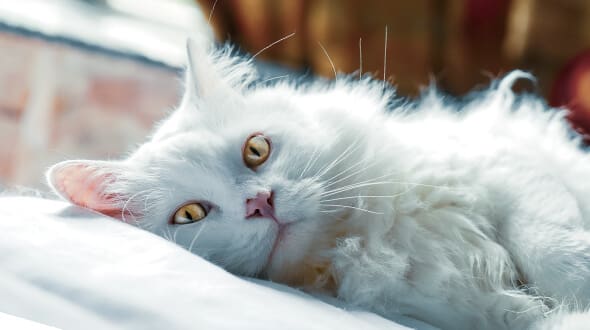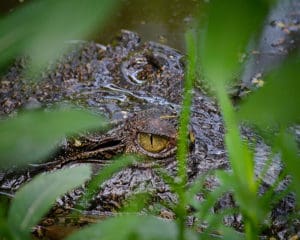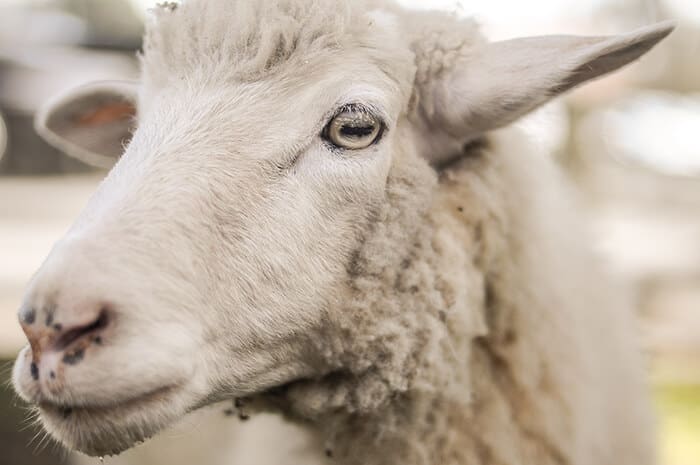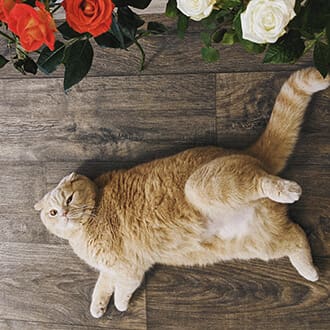 Ever wonder why cats have such striking eyes? They really are beautiful. Vibrant iris colors that shine like gems contrasted by stark, vertical pupils that make feline eyes seem much more intense than our own. We all know that most bits of anatomy have a specific purpose. A cat’s slivered pupils, in particular, are no exception. They are perfectly designed!
Ever wonder why cats have such striking eyes? They really are beautiful. Vibrant iris colors that shine like gems contrasted by stark, vertical pupils that make feline eyes seem much more intense than our own. We all know that most bits of anatomy have a specific purpose. A cat’s slivered pupils, in particular, are no exception. They are perfectly designed!
Cats have vertical pupils for two reasons. One is to enchant their people into serving them. We can vouch for this as willing servants who spent eight years at universities so that we could tend to everyone else’s cats too. (Maybe NC State’s Vet School should recruit a couple of cats to their admissions and marketing teams.)
The second and far more scientific reason? Cats are designed to be amazingly efficient predators. Ironic that domestic cats are still so great at this when all they have to do is just enchant their people into refilling the food bowl, eh?
 In a 2015 study of 214 animals, researchers concluded that vertical pupils are superior for judging depth, even in very low light conditions. This allows animals, and ambush predators in particular, sharp accuracy. If you’ve ever watched your cat slink around a corner then suddenly pounce on anything, you know that your little lion loves the thrill of the ambush and rarely misses the target.
In a 2015 study of 214 animals, researchers concluded that vertical pupils are superior for judging depth, even in very low light conditions. This allows animals, and ambush predators in particular, sharp accuracy. If you’ve ever watched your cat slink around a corner then suddenly pounce on anything, you know that your little lion loves the thrill of the ambush and rarely misses the target.
How does it work? Our brains take information from both eyes at the same time to give us one picture of what we’re looking at, to oversimplify it. This is called stereopsis. But if you close one eye and hold your finger up, then switch eyes to look at the same finger, it feels like your vision jumps because your brain is only getting the data from one eye at a time. The researchers found that vertical pupils are much better at measuring depth by way of stereopsis than other pupil shapes.
These pupils were found in nocturnal and polyphasic (active during day and night) animals. Of the animal subjects in the study, none of them were herbivores, which leads us to another interesting finding…

Horizontal pupils are common in animals that are more susceptible to being prey, including many grazing animals like goats, sheep, and horses among others like frogs. Having horizontal pupils is nature’s balance for vertical ones. They allow animals to have a sharper view of a wider horizon, compared to a cat that is great at pin-pointing a single target in front of it.
Guess what? Your kitty is a great hunter, descended from great hunters, but he or she doesn’t actually need to be. In fact, our cats are a paradoxical mix of their ancestry and of their modern lives. They very effectively and uniquely hunt for sport—not just food—while having a disproportionate effect on local wildlife. Mostly, they just prefer to sit on your laptop when you try to type, taunt your dog, knock things off your nightstand, and curl up in your lap until it’s time to request a stir of the kibble bowl again. And they are purrfectly happy living lives of luxury while chasing the occasional housefly around the house.
taunt your dog, knock things off your nightstand, and curl up in your lap until it’s time to request a stir of the kibble bowl again. And they are purrfectly happy living lives of luxury while chasing the occasional housefly around the house.
There’s no denying, though, that instincts and ability are powerful parts of who your cat is, and it’s great to indulge them with play that hones in on natural talents. Put those beautiful eyes and that feline brain to work by spending time each day with your cat and his or her favorite toys. Once you start thinking on what their eyes are doing right before they pounce and just how accurate each pounce is, you’ll be very impressed…as you should be. Meow.